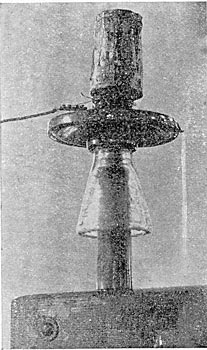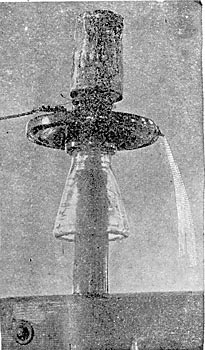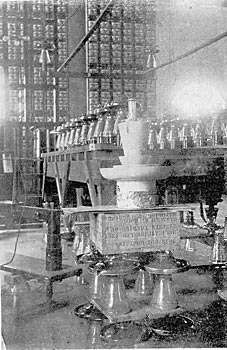[Trade Journal]
Publication: Electrical Review
New York, NY, United States
vol. 41, no. 13, p. 422-423, col. 1-2
Insulators for High Potentials.
One of the greatest troubles with which the engineer has had to contend in winter, when insulators, pins, cross-arms and poles became soaked with water, was the inevitable electrical breakdown. The dripping of water from exposed portions and the seepage along the edges of the large and heavy insulators gave rise to electrical leakages that were the sure forerunners of trouble. The accompanying illustrations are reproductions of half-tones from the description of the Bay Counties' system, published by the Journal of Electricity, Power and Gas, of San Francisco, Cal., and show what has resulted from a careful study of these conditions and a determined effort to supply a remedy. This consists in having a rim placed around the edge of the top piece of the insulator, in which the water is collected and run off as a solid stream from the spout. While, of course, the stream ran off in just an ordinary manner when the insulator was subject to no electrical pressure, the water was scattered outwardly as a spray when it was subjected to a high-potential charge. Mr. E. E. Starke secured the photograph from which these half-tones were made. The Locke "Victor" insulator, such as that used on the Bay Counties' high-tension lines, was mounted on a pin and cross-arm after the customary manner, and a leaking tin-can placed upon its top gave improvised rain. Fig. 1 shows how the water falls in a solid stream when no electrical potential is on the insulator. Fig. 2 shows how the same stream is scattered when a potential of 40,000 volts is applied to the insulator—scattered because the particles of water have each become electrified to a like polarity. As a result, the end portions of the insulators are always dry, and transmission at extremely high potentials becomes an assured and successful reality. Fig. 3 shows a saddle insulator under test. The insulator shown in the foreground is one of the great Locke porcelain insulators, weighing approximately fifty pounds each, and which after being installed in the Bay Counties' system have withstood long-continued tests of 120,000 volts. A test of 120,000 volts applied to an insulator to be used on a 60,000-volt line gives a factor of four, for inasmuch as two insulators are in series across the line, each is subjected to but 30,000 volts. These insulators are manufactured by Fred M. Locke, of Victor, N. Y., and are adapted to all potentials from 25,000 to 100,000 volts actual line voltage.
| |||
| Fig. 1. - the Water Runs Off in A Solid Stream at No Voltage. |
| |||
| Fig. 2. - How the Water is Split Up at 40,000 Volts. |
| |||
| Fig. 3. - A High-Tension Saddle Insulator Under Test of 120,000 Volts. |



